clutch YAMAHA SR125 2000 Owners Manual
[x] Cancel search | Manufacturer: YAMAHA, Model Year: 2000, Model line: SR125, Model: YAMAHA SR125 2000Pages: 78, PDF Size: 8.59 MB
Page 7 of 78
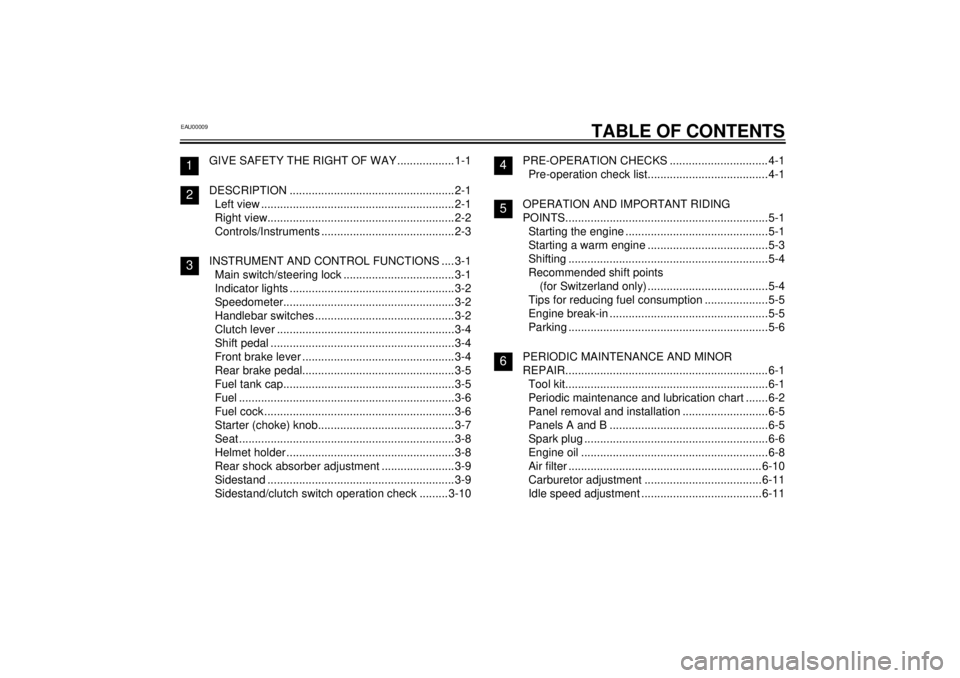
EAU00009
TABLE OF CONTENTS
GIVE SAFETY THE RIGHT OF WAY ..................1-1
DESCRIPTION ....................................................2-1
Left view ............................................................. 2-1
Right view...........................................................2-2
Controls/Instruments ..........................................2-3
INSTRUMENT AND CONTROL FUNCTIONS ....3-1
Main switch/steering lock ................................... 3-1
Indicator lights ....................................................3-2
Speedometer......................................................3-2
Handlebar switches ............................................3-2
Clutch lever ........................................................3-4
Shift pedal ..........................................................3-4
Front brake lever ................................................ 3-4
Rear brake pedal................................................ 3-5
Fuel tank cap......................................................3-5
Fuel ....................................................................3-6
Fuel cock ............................................................3-6
Starter (choke) knob...........................................3-7
Seat ....................................................................3-8
Helmet holder .....................................................3-8
Rear shock absorber adjustment .......................3-9
Sidestand ...........................................................3-9
Sidestand/clutch switch operation check ......... 3-10PRE-OPERATION CHECKS ...............................4-1
Pre-operation check list......................................4-1
OPERATION AND IMPORTANT RIDING
POINTS................................................................5-1
Starting the engine .............................................5-1
Starting a warm engine ......................................5-3
Shifting ...............................................................5-4
Recommended shift points
(for Switzerland only) ......................................5-4
Tips for reducing fuel consumption ....................5-5
Engine break-in ..................................................5-5
Parking ...............................................................5-6
PERIODIC MAINTENANCE AND MINOR
REPAIR................................................................6-1
Tool kit................................................................6-1
Periodic maintenance and lubrication chart .......6-2
Panel removal and installation ...........................6-5
Panels A and B ..................................................6-5
Spark plug ..........................................................6-6
Engine oil ...........................................................6-8
Air filter .............................................................6-10
Carburetor adjustment .....................................6-11
Idle speed adjustment ......................................6-11
123
456
E_3mw.book Page 1 Monday, February 5, 2001 9:54 AM
Page 8 of 78

TABLE OF CONTENTS
Throttle cable free play adjustment .................. 6-12
Cam chain adjustment ..................................... 6-12
Valve clearance adjustment ............................. 6-13
Tires ................................................................. 6-13
Wheels ............................................................. 6-15
Clutch lever free play adjustment..................... 6-16
Front brake lever free play adjustment ............ 6-16
Rear brake pedal height and free play
adjustment .................................................... 6-17
Brake light switch adjustment .......................... 6-18
Checking the front brake pads and
rear brake shoes .......................................... 6-19
Inspecting the brake fluid level......................... 6-20
Brake fluid replacement ................................... 6-20
Drive chain slack check ................................... 6-21
Drive chain slack adjustment ........................... 6-22
Drive chain lubrication...................................... 6-23
Cable inspection and lubrication ...................... 6-23
Throttle cable and grip lubrication .................... 6-23
Brake and shift pedal lubrication ...................... 6-24
Brake and clutch lever lubrication .................... 6-24
Center and sidestand lubrication ..................... 6-24
Front fork inspection ........................................ 6-25
Steering inspection .......................................... 6-26
Wheel bearings ................................................ 6-26
Battery.............................................................. 6-26
Fuse replacement ............................................ 6-28
Headlight bulb replacement ............................. 6-29Turn signal and tail/brake light bulb
replacement.................................................. 6-30
Front wheel removal ........................................ 6-30
Front wheel installation .................................... 6-31
Rear wheel removal ......................................... 6-32
Rear wheel installation ..................................... 6-33
Troubleshooting ............................................... 6-33
Troubleshooting chart ...................................... 6-34
MOTORCYCLE CARE AND STORAGE ............. 7-1
Care ................................................................... 7-1
Storage .............................................................. 7-4
SPECIFICATIONS ............................................... 8-1
Specifications ..................................................... 8-1
How to use the conversion table ........................ 8-5
CONSUMER INFORMATION.............................. 9-1
Identification number records............................. 9-1
Key identification number................................... 9-1
Vehicle identification number ............................. 9-1
Model label......................................................... 9-2
789
E_3mw.book Page 2 Monday, February 5, 2001 9:54 AM
Page 12 of 78

DESCRIPTION
2-3
2
Controls/Instruments1. Clutch lever (page 3-4)
2. Left handlebar switches (page 3-2)
3. Speedometer (page 3-2)
4. Front brake fluid reservoir (page 6-20)5. Right handlebar switches (page 3-3)
6. Front brake lever (page 3-4)
7. Throttle grip (page 6-12)
8. Main switch/steering lock (page 3-1)
E_3mw.book Page 3 Monday, February 5, 2001 9:54 AM
Page 16 of 78
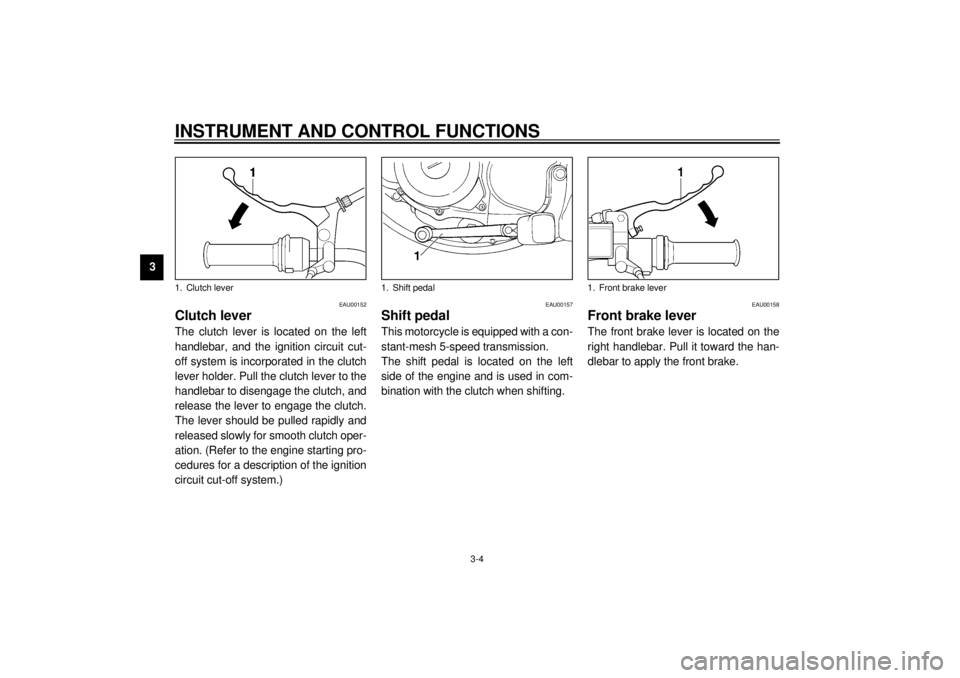
INSTRUMENT AND CONTROL FUNCTIONS
3-4
3
EAU00152
Clutch leverThe clutch lever is located on the left
handlebar, and the ignition circuit cut-
off system is incorporated in the clutch
lever holder. Pull the clutch lever to the
handlebar to disengage the clutch, and
release the lever to engage the clutch.
The lever should be pulled rapidly and
released slowly for smooth clutch oper-
ation. (Refer to the engine starting pro-
cedures for a description of the ignition
circuit cut-off system.)
EAU00157
Shift pedalThis motorcycle is equipped with a con-
stant-mesh 5-speed transmission.
The shift pedal is located on the left
side of the engine and is used in com-
bination with the clutch when shifting.
EAU00158
Front brake leverThe front brake lever is located on the
right handlebar. Pull it toward the han-
dlebar to apply the front brake.
1. Clutch lever
1. Shift pedal
1. Front brake lever
E_3mw.book Page 4 Monday, February 5, 2001 9:54 AM
Page 22 of 78
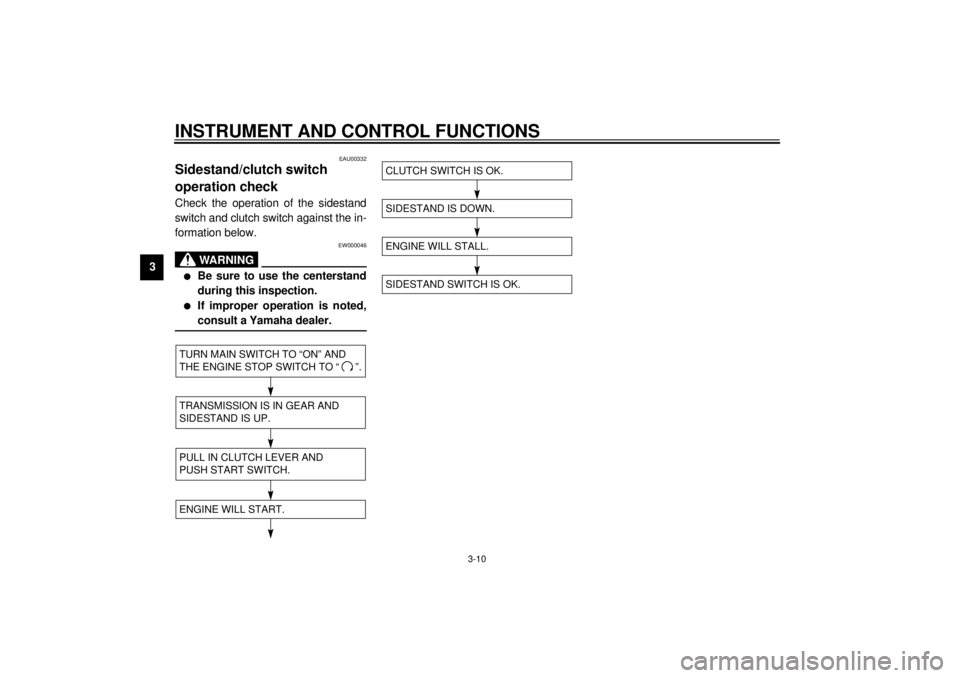
INSTRUMENT AND CONTROL FUNCTIONS
3-10
3
EAU00332
Sidestand/clutch switch
operation checkCheck the operation of the sidestand
switch and clutch switch against the in-
formation below.
EW000046
WARNING
@ l
Be sure to use the centerstand
during this inspection.
l
If improper operation is noted,
consult a Yamaha dealer.
@CD-08E
CD-08E
TURN MAIN SWITCH TO “ON” AND
THE ENGINE STOP SWITCH TO “ ”.TRANSMISSION IS IN GEAR AND
SIDESTAND IS UP.PULL IN CLUTCH LEVER AND
PUSH START SWITCH.ENGINE WILL START.
SIDESTAND IS DOWN.ENGINE WILL STALL.SIDESTAND SWITCH IS OK.CLUTCH SWITCH IS OK.
E_3mw.book Page 10 Monday, February 5, 2001 9:54 AM
Page 23 of 78
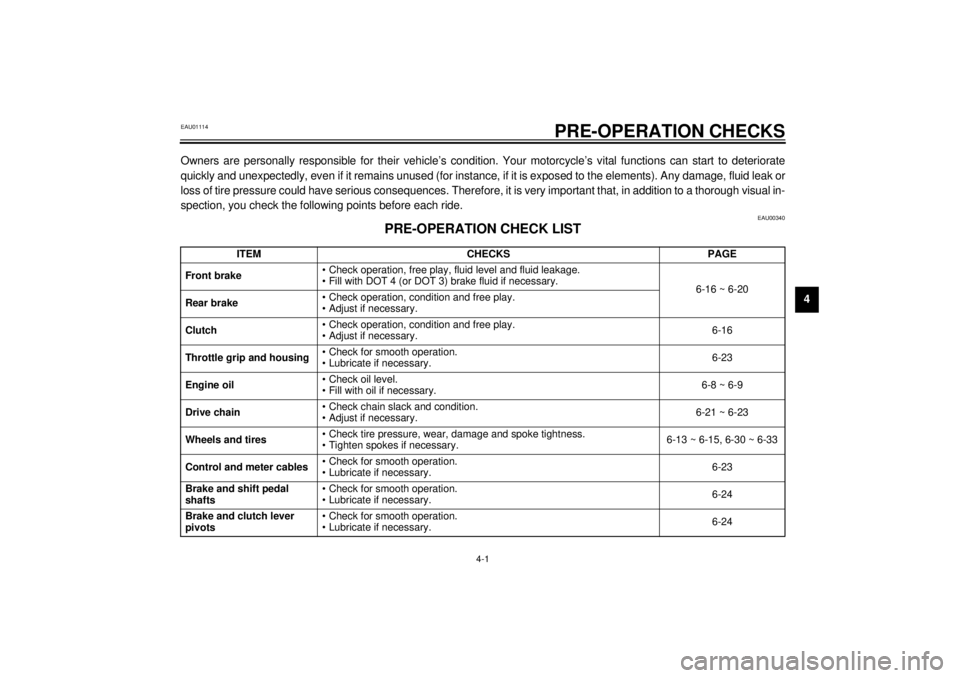
4-1
4
EAU01114
4-PRE-OPERATION CHECKS
Owners are personally responsible for their vehicle’s condition. Your motorcycle’s vital functions can start to deteriorate
quickly and unexpectedly, even if it remains unused (for instance, if it is exposed to the elements). Any damage, fluid leak or
loss of tire pressure could have serious consequences. Therefore, it is very important that, in addition to a thorough visual in-
spection, you check the following points before each ride.
EAU00340
PRE-OPERATION CHECK LIST
ITEM CHECKS PAGE
Front brake• Check operation, free play, fluid level and fluid leakage.
• Fill with DOT 4 (or DOT 3) brake fluid if necessary.
6-16 ~ 6-20
Rear brake• Check operation, condition and free play.
• Adjust if necessary.
Clutch• Check operation, condition and free play.
• Adjust if necessary.6-16
Throttle grip and housing• Check for smooth operation.
• Lubricate if necessary.6-23
Engine oil• Check oil level.
• Fill with oil if necessary.6-8 ~ 6-9
Drive chain• Check chain slack and condition.
• Adjust if necessary.6-21 ~ 6-23
Wheels and tires• Check tire pressure, wear, damage and spoke tightness.
• Tighten spokes if necessary.6-13 ~ 6-15, 6-30 ~ 6-33
Control and meter cables• Check for smooth operation.
• Lubricate if necessary.6-23
Brake and shift pedal
shafts• Check for smooth operation.
• Lubricate if necessary.6-24
Brake and clutch lever
pivots• Check for smooth operation.
• Lubricate if necessary.6-24
E_3mw.book Page 1 Monday, February 5, 2001 9:54 AM
Page 25 of 78
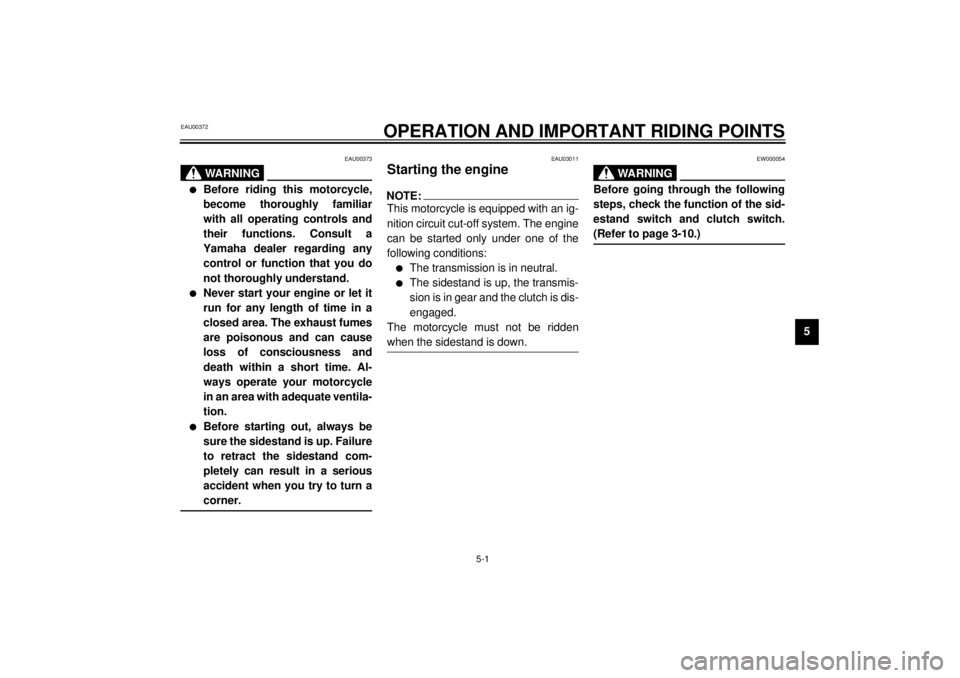
5-1
5
EAU00372
5-OPERATION AND IMPORTANT RIDING POINTS
EAU00373
WARNING
@ l
Before riding this motorcycle,
become thoroughly familiar
with all operating controls and
their functions. Consult a
Yamaha dealer regarding any
control or function that you do
not thoroughly understand.
l
Never start your engine or let it
run for any length of time in a
closed area. The exhaust fumes
are poisonous and can cause
loss of consciousness and
death within a short time. Al-
ways operate your motorcycle
in an area with adequate ventila-
tion.
l
Before starting out, always be
sure the sidestand is up. Failure
to retract the sidestand com-
pletely can result in a serious
accident when you try to turn a
corner.
@
EAU03011
Starting the engineNOTE:@ This motorcycle is equipped with an ig-
nition circuit cut-off system. The engine
can be started only under one of the
following conditions:l
The transmission is in neutral.
l
The sidestand is up, the transmis-
sion is in gear and the clutch is dis-
engaged.
The motorcycle must not be ridden
when the sidestand is down.
@
EW000054
WARNING
@ Before going through the following
steps, check the function of the sid-
estand switch and clutch switch.
(Refer to page 3-10.) @
E_3mw.book Page 1 Monday, February 5, 2001 9:54 AM
Page 26 of 78
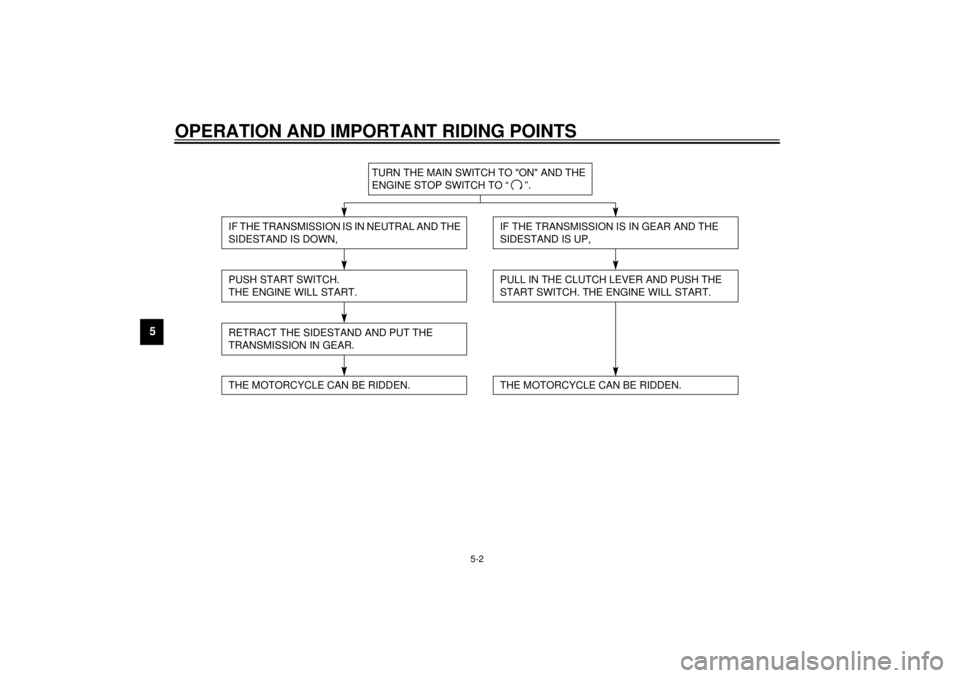
OPERATION AND IMPORTANT RIDING POINTS
5-2
5
CF-31E
TURN THE MAIN SWITCH TO "ON" AND THE
ENGINE STOP SWITCH TO “ ”.
IF THE TRANSMISSION IS IN NEUTRAL AND THE
SIDESTAND IS DOWN,PUSH START SWITCH.
THE ENGINE WILL START.RETRACT THE SIDESTAND AND PUT THE
TRANSMISSION IN GEAR.
IF THE TRANSMISSION IS IN GEAR AND THE
SIDESTAND IS UP,PULL IN THE CLUTCH LEVER AND PUSH THE
START SWITCH. THE ENGINE WILL START.
THE MOTORCYCLE CAN BE RIDDEN.
THE MOTORCYCLE CAN BE RIDDEN.
E_3mw.book Page 2 Monday, February 5, 2001 9:54 AM
Page 28 of 78
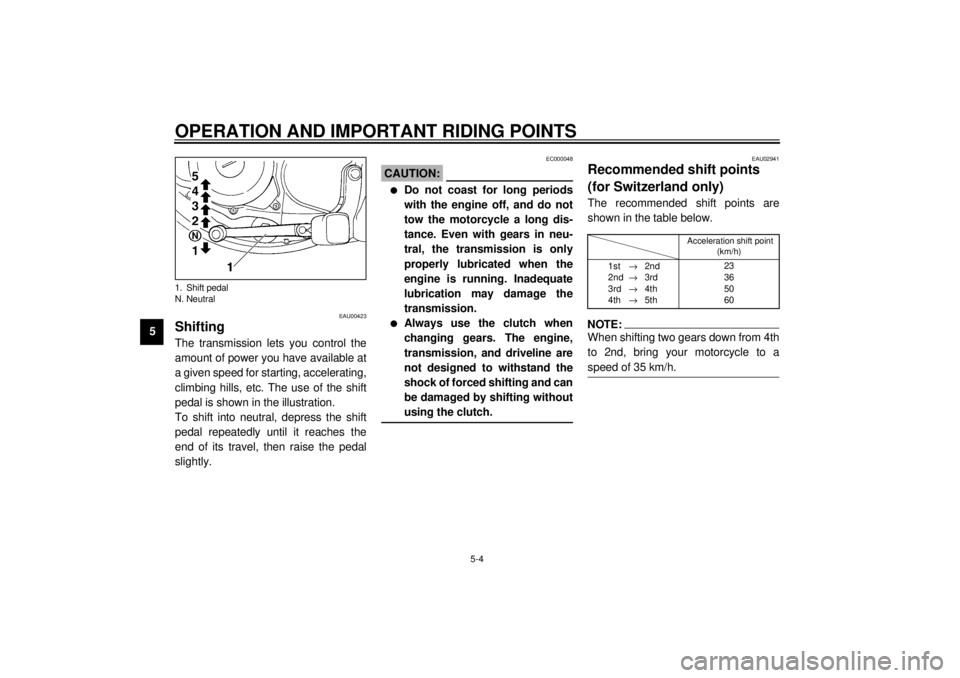
OPERATION AND IMPORTANT RIDING POINTS
5-4
5
EAU00423
ShiftingThe transmission lets you control the
amount of power you have available at
a given speed for starting, accelerating,
climbing hills, etc. The use of the shift
pedal is shown in the illustration.
To shift into neutral, depress the shift
pedal repeatedly until it reaches the
end of its travel, then raise the pedal
slightly.
EC000048
CAUTION:@ l
Do not coast for long periods
with the engine off, and do not
tow the motorcycle a long dis-
tance. Even with gears in neu-
tral, the transmission is only
properly lubricated when the
engine is running. Inadequate
lubrication may damage the
transmission.
l
Always use the clutch when
changing gears. The engine,
transmission, and driveline are
not designed to withstand the
shock of forced shifting and can
be damaged by shifting without
using the clutch.
@
EAU02941
Recommended shift points
(for Switzerland only)The recommended shift points are
shown in the table below.CF-25ENOTE:@ When shifting two gears down from 4th
to 2nd, bring your motorcycle to a
speed of 35 km/h. @
1. Shift pedal
N. Neutral
Acceleration shift point
(km/h)
1st®2nd
2nd®3rd
3rd®4th
4th®5th23
36
50
60
E_3mw.book Page 4 Monday, February 5, 2001 9:54 AM
Page 29 of 78

OPERATION AND IMPORTANT RIDING POINTS
5-5
5
EAU00424
Tips for reducing fuel
consumptionYour motorcycle’s fuel consumption
depends to a large extent on your
riding style. The following tips can help
reduce fuel consumption:l
Warm up the engine before riding.
l
Turn off the starter (choke) as
soon as possible.
l
Shift up swiftly and avoid high en-
gine speeds during acceleration.
l
Do not double-clutch or rev the en-
gine while shifting down and avoid
high engine speeds with no load
on the engine.
l
Turn off the engine instead of let-
ting it idle for an extended length
of time, i.e. in traffic jams, at traffic
lights or railroad crossings.
EAU00436
Engine break-inThere is never a more important period
in the life of your motorcycle than the
period between zero and 1,000 km. For
this reason we ask that you carefully
read the following material. Because
the engine is brand new, you must not
put an excessive load on it for the first
1,000 km. The various parts in the en-
gine wear and polish themselves to the
correct operating clearances. During
this period, prolonged full throttle oper-
ation, or any condition which might re-
sult in excessive heating of the engine,
must be avoided.
E_3mw.book Page 5 Monday, February 5, 2001 9:54 AM